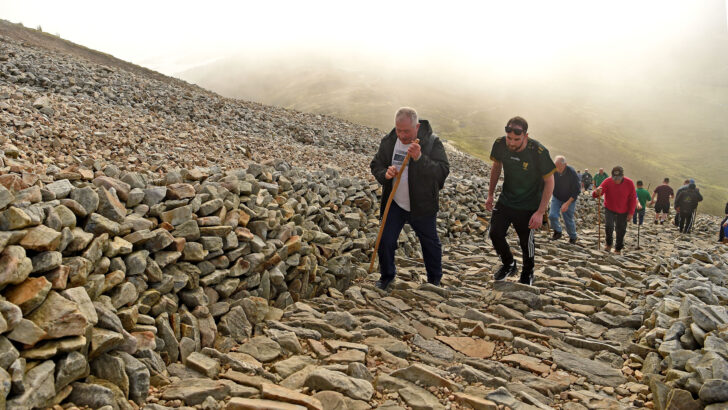Reek Sunday took place on Sunday last, the final Sunday of July as usual. The crowds were big. As usual. Mass was said every hour from dawn until dusk at the top of the mountain. Those climbing the iconic mountain do so on the back of a 1,500 year history of pilgrimage.
Many that climb it these days no longer do so as a pilgrimage. Fewer and fewer stop to observe the Mass and the Sacrament of the Eucharist. It is a sign of the times. So much of Ireland’s Christian heritage has been assumed by a post-secular society, with the religious element discarded, sometimes denied and often derided. But we also forget to allow God the space to do his thing in the hearts of those who climb, because climbing the Reek is a search, whether it’s for forgiveness, for peace or just for fun.
Why do so many people climb Croagh Patrick, Ireland’s holiest mountain, on this day of pilgrimage? They aren’t observing the original meaning but hanging on to the established traditions of Ireland’s Christian origins. Just as St Patrick is celebrated in increasingly profane ways on March 17, His original forty days’ of fasting is overlooked for some form of physiological collective day-out as a national holiday. And yet, the more the profane enters, the more the human heart longs for something else. Why else are the pilgrimage sites packed, why else are the Spanish complaining that too many are walking the Camino way?
Almost as well known is the pilgrimage to Lough Derg, which takes place between May and August where pilgrims (and others) take a one- or three-day retreat on Station Island, also known as St. Patrick’s Purgatory.
The place is so named because St Patrick, growing discouraged by the lack of faith of his converts in Ireland, asked God for reassurance, whereby God showed him a pit, called Purgatory, that St Patrick could show to his followers, so that they would know the reality of the joys of heaven and horrors of hell.
The Lough Derg pilgrimage, like that of Reek Sunday, has been encroached by people not seeking a Christian cleansing of the soul through penance, but a form of bodily detox and mindfulness through a spartan spa retreat. But again, God finds his ways through the cracks and spaces into the human heart.
In the same manner, the Camino de Santiago, probably the world’s most famous Christian pilgrimage route, has a modern-day appeal for hikers and people seeking a sense of achievement undertaking a long walk, benefitting from the structures – paths and hostels – that have been built on Christian history. At the culmination of the trek, many enjoy the ‘spectacle’ of the ‘Botafumeiro’, the giant incense burner being swung through the nave of the Cathedral, while having no interest in the Mass itself, without which it would not be taking place.
Pilgrimage has been part of the Catholic faith, it is thought, since 328AD when Saint Helena travelled to the Holy Land. During the Middle Ages, pilgrimage to the Holy Land became very popular. Most pilgrims travelled by foot, meaning these pilgrimages took years and were seen as a way to show true commitment to God and a way to be forgiven of sins.
The Catechism of the Catholic Church recognises the value of pilgrimage as a chance for Catholics to work on their faith. The Catechism states: Pilgrimages evoke our earthly journey towards heaven and are traditionally very special occasions for renewal in prayer (Catholic Catechism 2691).
Pope Benedict XVI said that “To go on pilgrimage really means to step out of ourselves in order to encounter God where he has revealed himself, where his grace has shone with particular splendour and produced rich fruits of conversion and holiness among those who believe.”
While it isn’t possible to resist the dilution of our pilgrimage heritage, there is also a deep desire especially among young people for experiential faith, climbing mountains, walking barefoot, holy water, incense, companionship in these tasks, all ingredients used by the Spirit to speak to the human heart. All we have to do is get young people to these places, and God will do the rest.


 Climbers making their way to the summit of Croagh Patrick, Ireland’s ‘Holy Mountain’, for
the annual pilgrimage which traditionally takes place every year on the last sunday in July. Photo: Conor McKeown
Climbers making their way to the summit of Croagh Patrick, Ireland’s ‘Holy Mountain’, for
the annual pilgrimage which traditionally takes place every year on the last sunday in July. Photo: Conor McKeown 